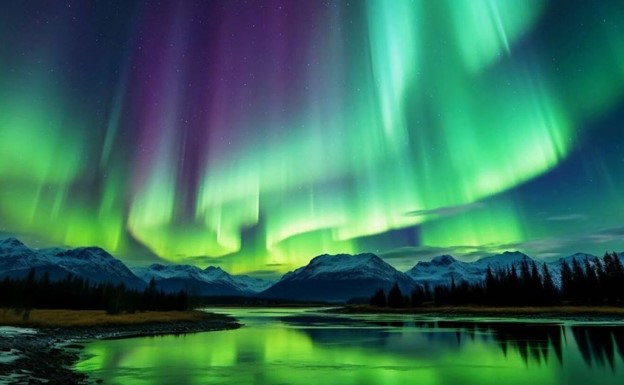The northern lights, also known as aurora borealis, have captivated humanity for centuries with their ethereal beauty and mysterious dance across the night sky. These awe-inspiring displays of light and color occur in the polar regions and are caused by the interaction between charged particles from the sun and the Earth’s magnetic field.
For those fortunate enough to witness this natural phenomenon, it is an experience unlike any other. The sky comes alive with shimmering curtains of green, blue, purple, and red, swirling and pulsating in a mesmerizing display of cosmic energy. It is a reminder of the vastness and wonder of the universe, and a testament to the beauty of our planet.
The northern lights have long held significance in various cultures around the world. In indigenous Arctic communities, they are often seen as spirits or celestial beings dancing in the sky. In Norse mythology, the aurora borealis was believed to be the armor of the Valkyries, warrior maidens who escorted fallen warriors to Valhalla. Across cultures, the northern lights have inspired awe, wonder, and reverence for the natural world.
Scientifically, the northern lights are a result of the interaction between the solar wind—a stream of charged particles emitted by the sun—and the Earth’s magnetic field. When these charged particles collide with atoms and molecules in the Earth’s atmosphere, they emit light of varying colors, creating the spectacular displays we see in the night sky.

The best time to view the northern lights is during the winter months in the polar regions, when the nights are long and dark. Locations such as Alaska, Canada, Norway, Sweden, Finland, and Iceland offer some of the best opportunities to witness this phenomenon. However, even in these regions, seeing the northern lights is not guaranteed, as they depend on various factors such as solar activity, weather conditions, and light pollution.
For those who are fortunate enough to witness the northern lights, it is an experience that leaves a lasting impression. It is a reminder of the beauty and majesty of the natural world, and a humbling reminder of our place within it. It is a moment of connection with something greater than ourselves, a glimpse into the cosmic dance of the universe.
In recent years, interest in the northern lights has grown, with more and more people traveling to the polar regions in search of this elusive phenomenon. Tour operators offer specialized aurora hunting trips, complete with expert guides and accommodations in remote wilderness locations. Photography enthusiasts flock to capture the beauty of the northern lights, armed with cameras and tripods to immortalize the experience.
However, as interest in the northern lights grows, so too does the need for responsible tourism practices. As visitors flock to the polar regions in search of this natural wonder, it is important to minimize our impact on the delicate ecosystems and indigenous communities that call these places home. Respect for the environment, local cultures, and wildlife is essential to ensuring that future generations can continue to experience the magic of the northern lights.
In conclusion, the northern lights are a testament to the beauty and wonder of the natural world. They remind us of the interconnectedness of all things and the importance of preserving the fragile ecosystems that sustain life on our planet. Whether viewed in person or admired from afar, the northern lights inspire awe, wonder, and a deep appreciation for the majesty of the cosmos.
Amidst the breathtaking spectacle of the northern lights, there exists a rare and enigmatic phenomenon known as the red aurora. Unlike the predominantly green and blue hues of the traditional aurora borealis, the red aurora casts a crimson glow across the night sky, signaling a unique and potentially dangerous event.
The red aurora occurs when charged particles from the sun interact with oxygen atoms in the Earth’s atmosphere at higher altitudes than those responsible for the more common green auroras. This interaction results in the emission of red light, creating a stunning yet ominous display that is both captivating and foreboding.
While the red aurora is undeniably mesmerizing to behold, it is also a reminder of the powerful forces at work in the cosmos. The same solar activity that gives rise to these dazzling displays can also pose risks to life on Earth. Intense geomagnetic storms, which are often accompanied by red auroras, have the potential to disrupt satellite communications, interfere with electrical grids, and even pose health risks to astronauts and airline passengers exposed to elevated levels of radiation.
Furthermore, the red aurora serves as a poignant reminder of the fragility of our planet’s atmosphere and the importance of understanding and mitigating the effects of space weather on Earth. Scientists continue to study these phenomena in order to better predict and prepare for their potential impacts, developing advanced technologies and monitoring systems to safeguard against the disruptions they may cause.
For those fortunate enough to witness the red aurora, it is a humbling reminder of the vast and dynamic nature of our universe. It is a testament to the beauty and complexity of the natural world, and a sobering reminder of the need for vigilance in the face of cosmic forces beyond our control. As we marvel at the splendor of the red aurora, let us also reflect on the importance of protecting our planet and preserving the delicate balance of life on Earth.















